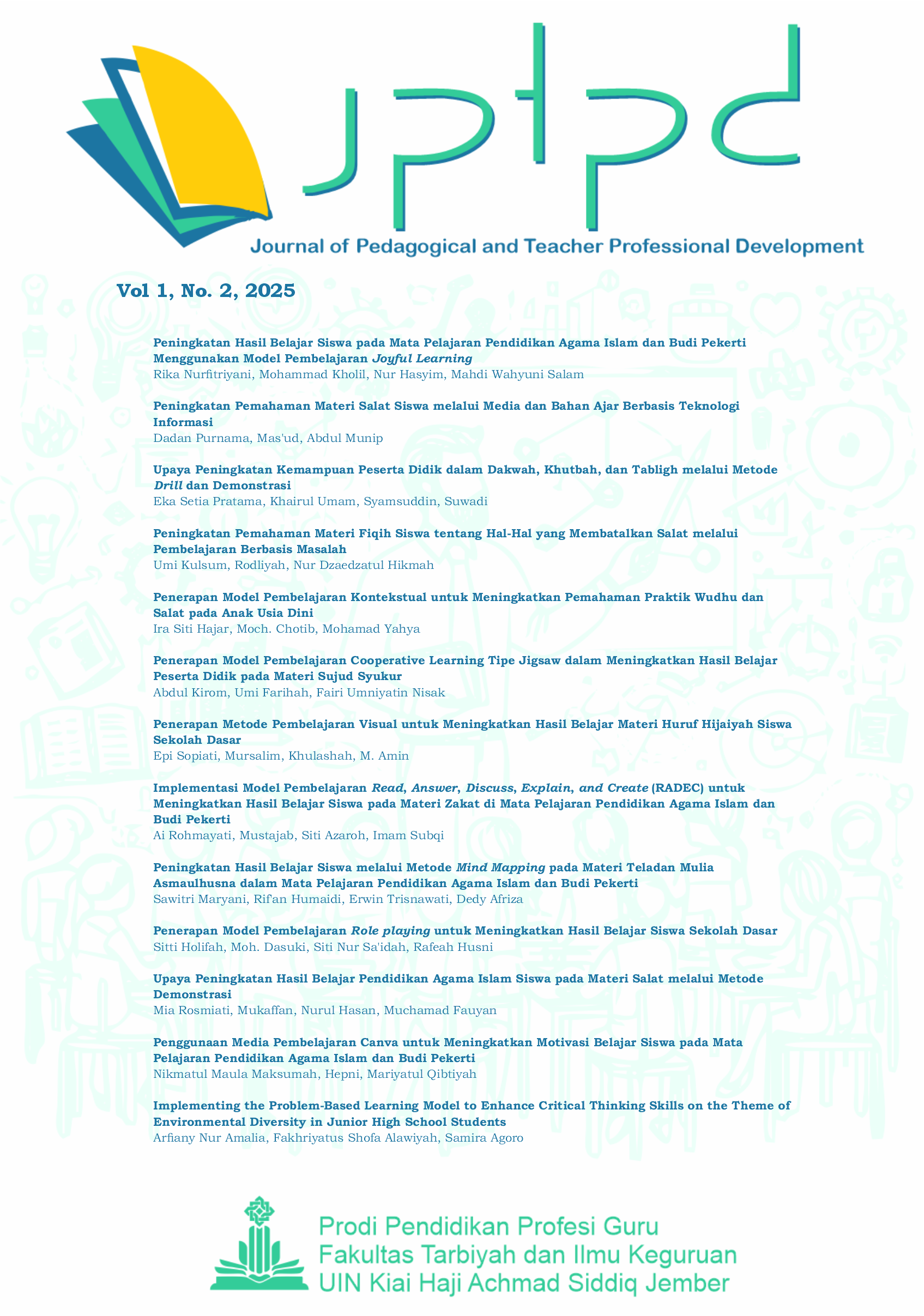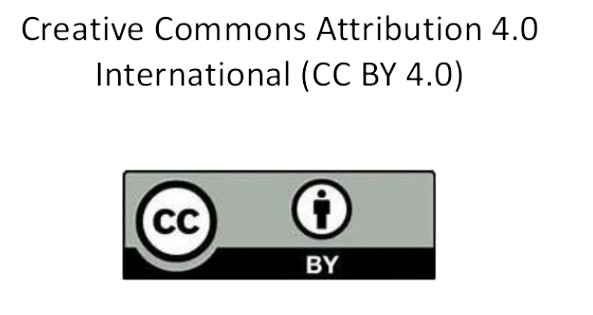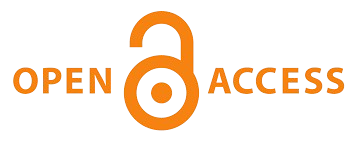Multiple Intelligences in Prospective Biology Teachers and Their Role in Self-Awareness and Learning Strategies
DOI:
https://doi.org/10.35719/jptpd.v1i2.980Keywords:
Multiple Intelligences, Prospective Teachers, Self Awareness, Teacher Education, Learning StrategiesAbstract
This study explores the multiple intelligences of prospective teachers and their role in self-awareness and learning strategies, with a focus on second-year students in the Biology Education program at UIN Kiai Haji Achmad Siddiq Jember. Using a qualitative descriptive research design, the study gathered data from 44 voluntarily participating students through multiple intelligence assessments, self-reflection questionnaires, semi-structured interviews, and Focus Group Discussions. The findings reveal that the most dominant intelligence type among respondents was intrapersonal intelligence (25%, n=11), followed by naturalistic intelligence (20.5%, n=9), and then musical intelligence (18.2%, n=8). This was followed by four intelligence types with the same percentage (6.8%, n=3), namely bodily-kinesthetic intelligence, spatial-visual intelligence, interpersonal intelligence, and logical-mathematical intelligence. Lastly, two intelligence types had the same number of respondents (4.5%, n=2), namely existential intelligence and linguistic intelligence. Students with high intrapersonal intelligence exhibited strong self-reflection and independent learning tendencies, while those with naturalistic intelligence preferred experiential, nature-based learning. This study highlights the importance of self-awareness in optimizing learning strategies and suggests that teacher education programs incorporate multiple intelligence-based approaches to support diverse learning styles.
References
Akkuzu, N., & Akçay, H. (2011). The design of a learning environment based on the theory of multiple intelligence and the study its effectiveness on the achievements, attitudes and retention of students. Procedia Computer Science, 3, 1003-1008. https://doi.org/10.1016/j.procs.2010.12.165
Alsaif, F. (2011). Intelligence-friendly environments: A study of New Zealand primary school classroom design in relation to multiple intelligences theory (Doctoral dissertation, Open Access Te Herenga Waka-Victoria University of Wellington). https://openaccess.wgtn.ac.nz/articles/thesis/Intelligence-Friendly_Environments_a_Study_of_New_Zealand_Primary_School_Classroom_Design_in_Relation_to_Multiple_Intelligences_Theory/16993465
Awwali, H. D. (2023). Strategi Guru PAI Dalam Mengembangkan Pembelajaran Berbasis Kecerdasan Majemuk (Studi Kasus Di Kelas XII IPS 2 SMA Muhammadiyah 9 Brondong Kabupaten Lamongan) (Doctoral dissertation, IAIN Kediri). https://etheses.iainkediri.ac.id/10157/
Bucher, H. (2023). (Non) Probability Sampling in Survey Research. Universitaet Mannheim (Germany). https://www.proquest.com/openview/53adf45fb08b82c4bd05189b17e94d24/1?cbl=2026366&diss=y&pq-origsite=gscholar
Daheri, M., Zulkifli, Z., Deiniatur, M., Rais, R., & Muhammadiah, M. U. (2022). Konfigurasi Pendidikan Karakter Berbasis Multiple Inteligences Sebagai Desain Pembelajaran Di Era Inovasi Disruptif. Jurnal Pendidikan Dan Konseling (JPDK), 4(5), 5136-5145. https://doi.org/10.31004/jpdk.v4i5.7463
Dolati, Z., & Tahriri, A. (2017). EFL teachers’ multiple intelligences and their classroom practice. SAGE Open, 7(3), 2158244017722582. https://doi.org/10.1177/2158244017722582
Dolev, N., & Leshem, S. (2017). Developing emotional intelligence competence among teachers. Teacher development, 21(1), 21-39. https://doi.org/10.1080/13664530.2016.1207093
Galiakberova, A. A., Khakimova, N. G., Khusnutdinova, R. R., & Gao, D. (2020). Professional training of teachers and the problems of their self-awareness. Journal of History Culture and Art Research, 9(1), 484-493. http://dx.doi.org/10.7596/taksad.v9i1.2559
Gardner, H. E. (2008). Multiple intelligences: New horizons in theory and practice. Basic books.
Gimbert, B. G., Miller, D., Herman, E., Breedlove, M., & Molina, C. E. (2023). Social emotional learning in schools: The importance of educator competence. Journal of Research on Leadership Education, 18(1), 3-39. https://doi.org/10.1177/19427751211014920
Lawrence-Brown, D. (2020). Differentiated instruction and inclusive schooling. In Oxford Research Encyclopedia of Education. https://doi.org/10.1093/acrefore/9780190264093.013.1223
Lindner, K. T., & Schwab, S. (2020). Differentiation and individualisation in inclusive education: a systematic review and narrative synthesis. International journal of inclusive education, 1-21. https://doi.org/10.1080/13603116.2020.1813450
Mulyati, M. (2019). Menciptakan pembelajaran menyenangkan dalam menumbuhkan peminatan anak usia dini terhadap pelajaran. Alim, 1(2), 277-294. https://doi.org/10.51275/alim.v1i2.150
Nasution, N. E. A., Putri, M. U., & Rizka, C. (2023). Analysis of Students' Learning Styles in Biology Subjects at Madrasah Aliyah Raudlatus Syabab Sukowono Jember. Pedagogi Hayati, 7(1), 1-11. https://doi.org/10.31629/ph.v7i1.6758
Romdaniyah, S., Nasution, N. E. A., & Rizka, C. (2023). Analysis of Biology Learning Planning on Plant Tissue Course in the Independent Learning Activity Unit (UKBM) based on Scientific Approach Class XI MIPA 5 at MAN Sumenep. META: Journal of Science and Technological Education, 2(2), 87–95. https://meta.amiin.or.id/index.php/meta/article/view/57
Saidi, M. (2020). Interpersonal and intrapersonal intelligences: are they related to EFL teachers’ self-efficacy beliefs?. AJELP: Asian Journal of English Language and Pedagogy, 8(1), 53-61. http://dx.doi.org/10.37134/ajelp.vol8.1.6.2020
Sarnoto, A. Z., & Fathoni, A. (2020). Pendidikan Islam Berbasis Kecerdasan Majemuk. Madani Institute| Jurnal Politik, Hukum, Pendidikan, Sosial Dan Budaya, 8(2), 1-12. https://doi.org/10.62097/jiep.v2i01.2072
Savitha, L., & Vijayalaxmi, A. H. M. (2018). Intervention program to enhance intrapersonal intelligence of teachers. International Journal of Home Science, 4(1), 9-12.
Sener, S., & Çokçaliskan, A. (2018). An investigation between multiple intelligences and learning styles. Journal of Education and Training Studies, 6(2), 125-132. https://doi.org/10.11114/jets.v6i2.2643
Shearer, B. (2018). Multiple intelligences in teaching and education: Lessons learned from neuroscience. Journal of Intelligence, 6(3), 38. https://doi.org/10.3390/jintelligence6030038
Sholeh, K., Kadaryati, K., Faizah, U., & Wahyono, H. (2021). Multi-intelligence-based literacy learning training to improve teacher pedagogic competence. Community Empowerment, 6(7), 1246-1254. https://doi.org/10.31603/ce.4550
Silwana, A., Manyunu, M., & Rashahan, A. A. (2021). Students’ responses leveling in solving mathematical problem based on SOLO taxonomy viewed from multiple intelligences. Indonesian Journal on Learning and Advanced Education (IJOLAE), 1-16. https://doi.org/10.23917/ijolae.v3i1.10528
Soleh, K., & Nurhidayati, N. (2017). Gerakan Lierasi Sekolah Berbasis Kecerdasan Majemuk Berorientasi Pembelajar Sepanjang Hayat Bagi Guru Sd/Mi di Padureso Kebumen. Surya Abdimas, 1(1), 54-61. https://doi.org/10.37729/abdimas.v1i1.312
Sugiyono, D. (2013). Metode penelitian pendidikan pendekatan kuantitatif, kualitatif dan R&D.
Wahyudi, M., Arisanti, F., & Muttaqin, M. A. (2024). Pendekatan Holistik Dalam Pendidikan Anak Usia Dini: Menyelaraskan Aspek Kognitif, Emosional dan Sosial. Journal Of Early Childhood Education Studies, 4(1), 33-72. https://doi.org/10.54180/joeces.2024.4.1.33-72
Downloads
Published
How to Cite
Issue
Section
License
Copyright (c) 2025 Journal of Pedagogical and Teacher Professional Development

This work is licensed under a Creative Commons Attribution 4.0 International License.











